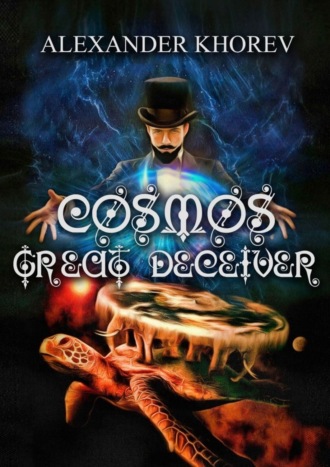
Полная версия
Cosmos – Great Deceiver
There is a paradoxical situation. We cannot see the real energy impulse that our Universe is.
But these paradoxes of time does not end. Another paradox of time is that these stages appear to the observer at the same time, as if in the present tense “here and now.” They appear before the observer at the same time, starting almost from the moment of the Big Bang and the formation of the first stars and galaxies, and ending with nearby space objects. Moreover, all these types of past tense, starting from the most distant and ending with the closest, look as if it is a real present. Reality for the observer is not the reality of the cosmos. Cosmic space with a single objective time does not exist for the observer. But he sees at the same time all the stages of the development of the Universe, and time is also as if absent because the observer sees all the past of the Universe at the same time.
Now directly about the time.
What is characteristic of time. We know that time is divided into present, past and future.
In the present tense the action takes place now. In the past tense, the action has already happened, and in the future – the action has yet to occur. From the point of view of the observer, the past and the future are not real events, but information about past or supposed events, that is, there is no event, there is only information that it was or will be. Well, the present is different from the past and the future in that the event is actually happening at this moment in our physical world. No matter how short the event is, it still takes some time.
I somehow wondered how long the present really lasts before becoming the past. It turned out that the past is here, near. There was only now, but already became the past. I tried to define a time frame for the present. I tried to draw a scale on which, on the one hand, I postponed the future, and on the other, the past. Both the future and the past on the scale could be continued indefinitely, but the present between them lasted only a moment. I called it the “moment of the present.” Moreover, it was impossible to determine the time frame of the present. I even turned to the microworld and found out, for example, that some elementary particles live their turbulent life from birth to death in 10—27, that is, in 0.0000000000000000000000001 seconds. But you can add a few more zeros to this short present and still not catch it. As far as one can continue the future and the past, one can infinitely shorten the present. The result was a strange thing: the future does not exist, because it has not happened yet, the past does not exist, because it has already happened, and there is no present, because – because … Mathematically, the “moment of the present” can be described as:
Т1 – Т0, where Т1 is the time of the end of the event, and Т0 is the beginning of the event. Question:
How long is the “moment of the event”, how long is the present?
Where does the future end and the present begin, where does the present end and the past begin?
It seems that there is no present time at all. I had to pretty much break my head in an attempt to catch the present. Thinking over this paradox, I asked myself: “But how do I feel the present, because I feel it?” The answer was no less paradoxical: “I always feel the present!” Compared with the real physical world, where there is no present, it turns out that in my soul, past tense is stored in the form of memories, future tense – in the form assumptions, and the present time always reigns. And that which lasts always, does not actually move, but that which does not move does not have time, and that which does not have time does not have space either. That is, in my soul there is neither time nor space, there is always only one present. I called this state “here and now” as opposed to the “moment of the present”. The result is that the future and the past belong to the external physical world, and the present is an affiliation of the spiritual world. In this, the present is akin to an energy impulse. It turns out that the present does not fit in with either the future or the past. If we again take the time scale with the plus “future” and minus “past”, then for the present just zero is left – the absence of an event. Plus is the intended action, minus is the past action, zero is the absence of action. It turns out a paradox: there is no action at all. At first, it is supposed to be about to be, and then – it has already happened, but at the moment it does not exist either. You can rephrase the phrase “The future will never come” and say: “The present will never come”. But the real physical world around us is changing, it exists! Well, and events that seem to occur right in front of our eyes here and now at arm’s length?.. Let’s say we look through a microscope like microbes are crawling. But microbes also have a certain distance, and in order to cover this distance, information is in the form of photons of light at a speed of 300 thousand kilometers per second. should also spend some time. Of course, not billions of years, but fractions of a second, but for as long as the information went before the observer’s eye, the situation of microbes also changed, and some of them also no longer exist, because they have a short life.
Could the present be absent in the real physical world?
And what then is our physical world in which there are not events themselves, but only information about them, only a shadow of events; events in which the “moment of the present” happened once in the past?
We live in a world of shadows, in a world filled not with events, but with information about events!
Here we come to such an interesting phenomenon full of paradoxes as the past tense. The past time can be divided into the near and far. It would seem that the past is what was and therefore we cannot see it in the present. But the paradox is that we don’t see the present, but we see only the past. We, our soul, are in the present tense, but we cannot see what we are part of. Near us is the near past. The event just happened. We are separated from him by centimeters or meters. Oddly enough, but the past tense is the distance as well. By the time we are separated from the nearest past seconds and minutes.
And the distant past is better studied by looking at the stars, because the past that is closest to us still gives away to the present. In fact, there is almost no distance to the nearest past to us and, accordingly, time. Another thing stars. That’s the past so the past. Thousands and millions of years and distances are appropriate. The distant past will be measured in light years. But if the near past time can be considered almost present, then the cosmic past time is really the past time, and it is directly related to the speed of light. The speed of light is known to be 300 thousand kilometers per second. So what happened at a distance of 300 thousand kilometers from us, behind the present time by 1 second. Just at this distance from us is the moon. Let’s try to portray it.
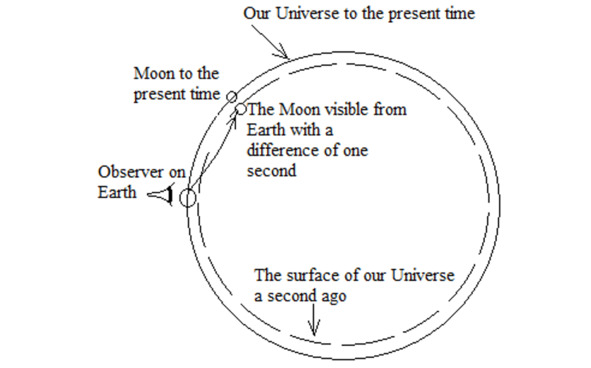
The circle is our Universe or the perimeter of a constantly expanding energy impulse after the Big bang, on which our Earth, Moon, Sun, all stars and galaxies are located, in short, all the matter of space. All space objects located along this perimeter have the same time – the real present time. But the paradox is that space objects do not see each other in the present time in which they are located. One object begins to see another object only when the light from it reaches another object, and this takes time. As the signal goes from one object to another, the location of the source object changes, because the Universe is constantly expanding. The observer sees the space object in the same place and position as he was when he sent a signal to the observer.
The moon is very close to the present. It is only 1 second behind the present. But this is still not real. The moon is no longer in the place where it was a second ago. This is the past that was present a moment ago.
The sun, we see behind the present by 8 minutes. That is what we see was real 8 minutes ago. But it is also almost present
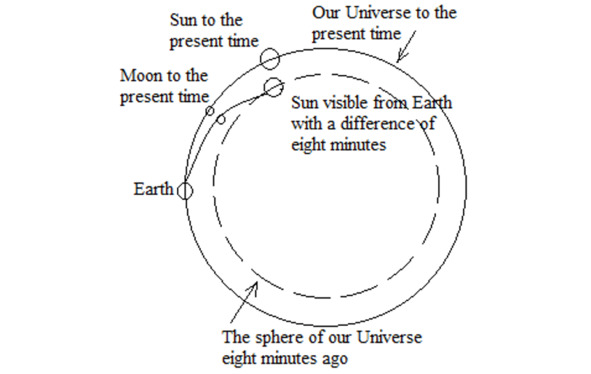
The closest star of Alpha Centauri we now see in the place where she was more than four years ago. And so on.
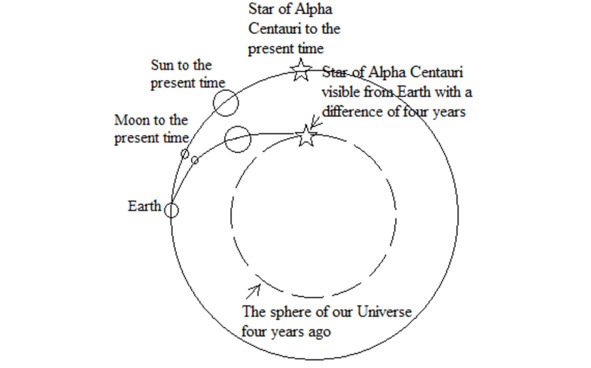
Information moves away from us at the speed of light only in the opposite direction and deeper into the past. Thus, if our Universe is a sphere in which the real present is around the perimeter, then information about all space objects in this sphere is provided to the observer late for a second every 300 thousand kilometers and forms an arc dating back to the Big Bang and nearly 14 billion years in time. The observer does not see the real Universe, but sees just this arc of past tense. The speed of light gives the observer information about the past of our Universe, about its development right up to its birth. Only the nearest space objects more or less coincide with their real location, but from a certain distance they are no longer cosmic objects, but phantoms that are not present in reality at the place where we see them, or maybe even no longer exist.
The deeper into space, the farther into the past. The distances to the stars can mark the epochs of the earth. Say you can find the stars from which the light comes to us from the era of ancient Rome. That is, imagine this star, we see what it was in the era of ancient Rome. And even further you can reach the era of dinosaurs. In general, we can outline the mental circles in space, corresponding to different Earth epochs until the appearance Earth itself and even the solar system. But these circles outlined by us mean that the Universe was smaller.
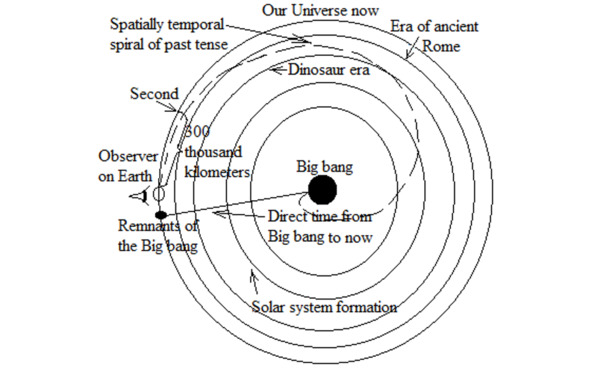
If we assume that with the help of more and more advanced telescopes, we can see the entire sphere of the energy impulse, that is, our Universe, then the most distant cosmic objects will be located on this sphere literally behind us. And the Big Bang will be located behind us, that is, the remains of the Big Bang after 14 billion years. But it is impossible to turn back. We will always see only the beginning of the process. Drawing circles, outlining the epoch, we thereby outline the perimeter of the Universe of that time.
The dashed line indicates what the earth observer sees in the sky. I called this visible part of the sky a space-time spiral. It demonstrates a decrease in the size of the Universe up to the Big Bang.
Конец ознакомительного фрагмента.
Текст предоставлен ООО «ЛитРес».
Прочитайте эту книгу целиком, купив полную легальную версию на ЛитРес.
Безопасно оплатить книгу можно банковской картой Visa, MasterCard, Maestro, со счета мобильного телефона, с платежного терминала, в салоне МТС или Связной, через PayPal, WebMoney, Яндекс.Деньги, QIWI Кошелек, бонусными картами или другим удобным Вам способом.



